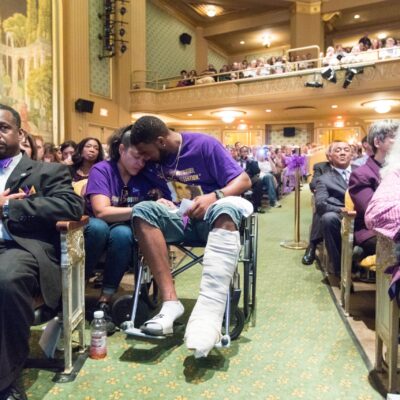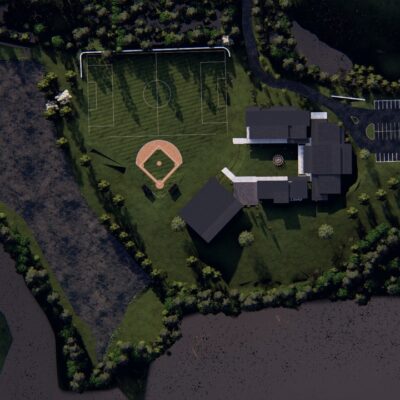This spring, high school athletes in Albemarle County Public Schools will receive a belated Christmas gift from an anonymous donor and county supervisors: state of the art synthetic field turf for the football fields. Thousands of students will walk, run and fall on that surface while playing football, field hockey, soccer or lacrosse. Though each field costs $600,000, maintenance will be a heck of a lot easier, and their durability will allow the broader community to play on the fields when they aren’t in use for high school games.
But are these new fields really a gift—or a curse? In order to save maintenance money in the short term, Albemarle County is taking a gamble on a new product that may (or may not) have health risks.
Converting grass playing fields to synthetic turf ones has been a growing trend nationwide. But possible health risks have led to debate in many communities: Last month, parents in the San Jose Unified School District stopped officials from installing fake turf at an elementary school, and the State of Connecticut last week agreed to study health and environmental impacts of synthetic turf after mounting concerns.
Locally, however, the debate has hardly been fierce. Local public high schools were prompted to convert their grass fields to artificial turf after an anonymous donor
|
Jon Pritchett, CEO of the company supplying the artificial turf, says the field overheating is “more of a discomfort issue than a safety issue.” |
contributed $1.3 million expressly for that purpose. The county School Board was satisfied about the safety of the fields when it voted in favor of the turf in 2007, and when the Board of Supervisors weighed whether to allocate $225,000 for the cause, no worried parents showed up to a meeting on the subject this past December. Only two of the six supervisors, David Slutzky and Ann Mallek, were concerned enough to vote against the turf.
What’s far from comforting is that the pair were assigned by the rest of the Board to look into the health risks of fake turf—and after doing so, they remained unsatisfied. “I am not convinced that they are dangerous, but I am certainly not convinced that they are safe,” says Slutzky.
Slutzky says he tried to push the Board to dedicate more time and do more research before reaching a final decision. Even in the event of an unfavorable vote by the Board, he says, he would have liked to hold a public hearing on the health and safety concerns.
“I’d rather have a good, open and public dialogue first,” he says. “If the community has a strong desire to keep these fields in because of the benefits they represent, so be it. We’ll move forward with our eyes open.”
That could still happen for Charlottesville city schools. But in the county, Albemarle High has already raised the entire sum needed, Monticello and Western Albemarle aren’t far off the mark, and installation is slated to begin this spring.
Before hordes of students hit the fields, C-VILLE wants to make sure that you have the chance to weigh the facts for yourself.
The argument for fake turf
• Less expensive to maintain.
While the initial investment to install the turf is costly—$600,000—the upkeep is much less expensive. Fitzgerald Barnes, athletic director at Monticello High School, says that annual maintenance costs would drop from up to $35,000 to $5,500 when the new surface, AstroTurf Gameday Grass 3DX, is installed.
UVA has four fields with synthetic turf: two football practice fields, a field hockey field and a general practice field. Ethan Saliba, UVA’s associate AD for sports medicine and head athletic trainer, says the difference in cost is dramatic.
|
Fitzgerald Barnes, AD for Monticello High, says that by installing turf, the maintenance costs will decrease significantly. |
“They spend thousands and thousands of dollars every summer, which now doesn’t have to happen,” he says. “Now, you are ready to go and you are not policing whether the field is ready or not.”
The reason is that natural grass wears out a lot faster—those bald dirt patches that mar fields that are overused. As an extra benefit, fake turf, unlike grass, doesn’t require pesticides and fertilizers. Jon Pritchett, CEO of General Sports Venue, says the turf he is supplying can last up to 10 years.
Jason Bauman, UVA’s associate athletics director for Facilities and Operations, says that grass was a struggle to maintain because of the use UVA puts on the fields.
“We had to try to limit use and we needed to put it in safe, playable conditions,” he says. “Now we have this surface and we can play on it all the time. It’s been really good to us.”
• Broader access.
To keep a grass field from becoming a dust bowl, use has to be limited. Currently, county high school teams use their football fields, but few others. With artificial turf, that can change, says Barnes.
“This will allow the community to have some fields that youth sports can use, and it would really help youth organizations to have practice, because they don’t have practice space right now,” he says.
The argument against fake turf
• The lead hazard.
When kids take the field this fall in Albemarle County high schools, they will basically be playing on plastic and old tires. What will look like grass is really polyethylene. Taking the place of dirt is ground up tires. In the parlance of field turf, it’s called “crumb-rubber infill.”
While it’s commendable to recycle old tires, some environmental and health advocates have raised questions about the chemicals in that field turf.
|
Jackie Lombardo, member of the Sierra Club Toxics Committee, is concerned about the unknowns in the debate over synthetic turf. “Saying that they are safe because they don’t contain lead is like saying cigarettes are safe because they don’t contain lead,” she says. |
In April, two fields in Newark, New Jersey, were closed after state health officials tested elevated levels of lead in worn turf made of nylon fibers and in dust. After tests were conducted on 12 fields in the state, the New Jersey Department of Health and Senior Services announced it believed that lead from the artificial turf fields alone would not result in lead poisoning among children who played on those surfaces, but it cautioned about the effects of a continuous exposure to lead from used types of turf fibers. The Center for Disease Control and Prevention issued a health advisory warning about the potential exposure to lead in artificial turf.
Though the U.S. Consumer Product Safety Commission (CPSC) dubbed the fields “safe,” in December, New York City officials closed an East Harlem soccer field with 5-year-old fake turf because of elevated lead levels.
Pritchett says lead isn’t an issue for Albemarle to worry about. “The lead chromate is no longer used in our new formulation, so what Albemarle is buying, for example, doesn’t even have the lead chromate it,” he says.
For Jackie Lombardo, local resident and member of the Sierra Club National Toxics Committee, the most troubling aspect of the debate is the uncertainty.
“We know older turf products contain toxic chemicals associated with asthma, learning disabilities, and cancer,” says Lombardo. “Saying that they are safe because they don’t contain lead is like saying cigarettes are safe because they don’t contain lead. There are many other chemicals that are in this synthetic grass and we don’t know what the effects are going to be not only on children’s health, but also what the effects are on the ground water as well.”
• The zinc hazard.
Although lead seems to have attracted the most attention, some believe another harmful chemical is found in the rubber.
“The ground-up rubber tires have just a ton of zinc,” says Nancy Alderman, president of Environment and Human, Health Inc. Alderman’s organization is a Connecticut-based nonprofit that has questioned the safety of these synthetic turf fields for years.
|
Schools in Albemarle County are planning to install AstroTurf Gameday Grass 3DX, which is manufactured by General Sports Venue. [click image to biggerize it!] |
A study by the University of North Carolina at Chapel Hill cites cardiovascular damage as a possible consequence of continued exposure to zinc. A study by the North Carolina Department of Agriculture and Consumer Services linked high levels of zinc to a decline in plant growth. With as little as 2 percent of zinc mixed with sand, plants stopped growing as a direct cause of zinc’s toxicity.
In addition to zinc, the rubber could contain other metals such as arsenic, cadmium, chromium, lead or selenium, according to Alderman.
• The heat hazard.
According to a Brigham Young University study, the surface temperature of synthetic turf of the university’s football practice field was 37 degrees higher than asphalt and 86.5 degrees hotter than natural grass. “On very warm days, when we know from tests it is 90 degrees out, the fields get up to 160 degrees,” says Alderman. “I don’t think anyone should play on fields that are 160 degrees.”
Although a correlation between the solar impact and the temperature on the fields is evident, Pritchett says there are temperature management programs to ensure athletes are kept out of the hottest times of day. “It’s more of a discomfort issue than a safety issue,” he says. “I am not aware of any safety problems or overheating or anything relative to using the fields in intense heat.”
Barnes, Monticello AD, assured supervisors that students would be playing on the field after 5pm, “when heat is not a big factor.”
According to Saliba, overheating is not an issue at UVA. “We are very careful in regards to making sure that [the athletes] stay hydrated,” he says.
Bauman says the fields are very safe. To combat the heat issue, “we install in each of our fields an irrigation system, that allows us if we want to throw out water at them, we can do it pretty quickly.”
Monticello High, however, will not install an irrigation system.
An imperfect solution
If money wasn’t an issue, it would be a no brainer to stick with grass. Even though UVA has put artificial turf on its practice fields, there’s a reason Scott Stadium still encloses a grass field.
“You can’t beat natural turf if you can take good care of it, and the athletes can definitely tell whether it’s natural grass,” says Saliba.
But though Bauman says that the University athletic staff loves the grass at Scott Stadium, he also points out that the use of the field is very different from what the practice fields are used for. “Our priority is to make sure that we can consistently deliver safe, playable fields for our athletes, and with [the turf], the fields were able to do just that,” he says.
For more than a decade, the NFL Players Association has surveyed its players about the fields on which they play. In its first survey in 2004, players overwhelmingly preferred natural grass over synthetic turf for safety reasons. But much has changed and, according to NFL officials, there are better fields today than there were a decade ago.
In the earlier generations of the turf, says Saliba, “both the support staff and the athletes would moan, because shock absorption isn’t there and it hurts,” compared to natural grass. “The grass would still have better shock absorption [than] these high quality field turfs, but again, we got minimal complaints from the athletes.”
Lombardo says the Sierra Club understands people’s enthusiasm for a new product that may allow more playing time for children. “But with the financial crisis that we are in,” she says, “[county supervisors] just handed over a quarter of a million dollars of taxpayers’ money without looking into potential problems down the road: problems with water, problems with soil, and potential problems for kids’ health.”









